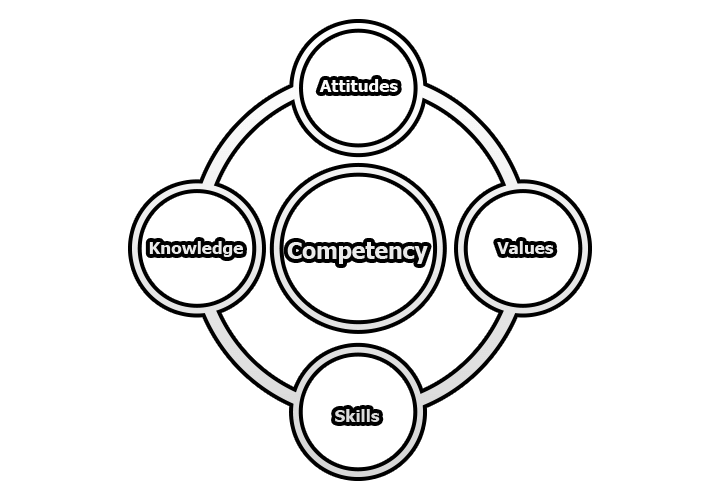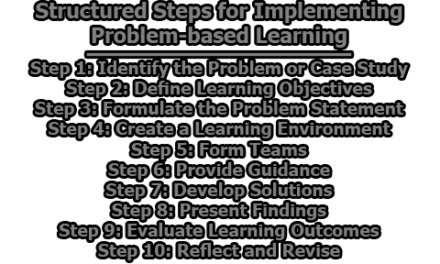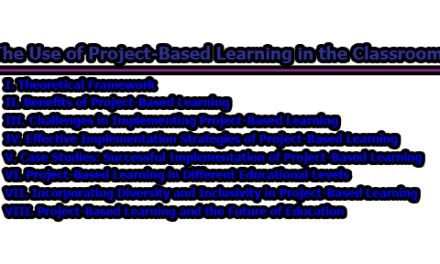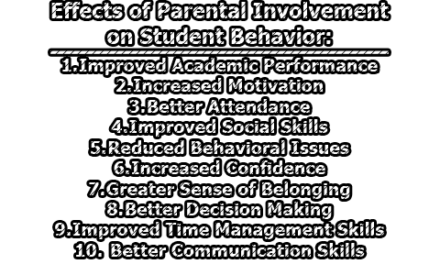Significance and Elements of Competency:
Competency is a fundamental concept in education and professional development that goes beyond traditional knowledge acquisition. It represents a holistic readiness to navigate the complexities of life, work, and society, integrating knowledge, skills, values, and attitudes. This article explores the significance and elements of competency; and its impact on modern education and personal development.
Defining Competency:
Competency can be defined as the integrated capacity to effectively apply a combination of knowledge, skills, values, and attitudes in specific contexts to achieve desired outcomes or solve particular problems. It represents a comprehensive readiness to navigate the complexities of life, work, and society.
Significance of Competency:
Competency, encompassing knowledge, skills, values, and attitudes, holds profound significance in the contemporary world, contributing to the holistic development of individuals and their readiness to face the challenges of an ever-evolving society.
1. Real-World Application: Competency-based education emphasizes the practical application of knowledge, skills, values, and attitudes (Hodges et al., 2013). This approach equips individuals with the ability to excel in diverse, dynamic, and complex environments (Perkins & Salomon, 1988). Learners are not passive recipients of information; they are active participants in acquiring competencies that are directly applicable to real-life situations (Anderson et al., 2001). This prepares individuals to navigate the complexities of their personal and professional lives with confidence (Moss et al., 2019).
2. Lifelong Learning: Competency-focused approaches promote lifelong learning (Long et al., 2017). Individuals recognize the need to continually update and expand their competencies to adapt to changing circumstances (Bologna & McGinn, 2018). Competencies are not static; they evolve alongside societal, technological, and economic changes (Manderson et al., 2018). This commitment to ongoing learning ensures that individuals remain relevant and adaptable in their personal and professional lives (Cedefop, 2019).
3. Holistic Development: Competency development addresses not only cognitive aspects (knowledge and skills) but also emotional and ethical dimensions (values and attitudes) (UNESCO, 2005). This holistic approach leads to well-rounded individuals capable of making positive contributions to society (Aspin et al., 2012). It fosters adaptability, ethical behavior, and a sense of responsibility toward one’s community and the world at large (Ehrenberg & Hamilton, 2020). Competencies go beyond academic achievement, emphasizing personal growth and character development (Dixon & Ryan, 2019).
4. Problem Solving: Competency equips individuals with the tools needed to tackle complex problems, make informed decisions, and navigate ethical dilemmas effectively (Shulman, 1987). In today’s interconnected world, challenges often transcend disciplinary boundaries (Hakkarainen et al., 2000). Competencies enable individuals to approach problems with a multidisciplinary perspective, drawing from diverse knowledge and skills (Schoenfeld, 1985). This problem-solving capacity is crucial for addressing global issues and contributing to positive societal change (Pellegrino & Hilton, 2012).
5. Employability: Employers increasingly seek candidates with a well-rounded set of competencies (Dietrich & Kracke, 2009). Recognizing that individuals with competencies are better equipped to thrive in the workplace (Hanushek & Woessmann, 2016), organizations value employees who can adapt, innovate, and collaborate effectively (Bridgstock, 2016). Competencies, both technical and soft, contribute to enhanced job prospects and career success (Van Dam et al., 2018).
The Four Elements of Competency:
Competency is a multifaceted concept that extends beyond traditional education, encompassing four essential elements: knowledge, skills, values, and attitudes (Spencer & Spencer, 1993).
1. Knowledge: Knowledge serves as the foundational element of competency (Schleicher, 2018). It encompasses factual information, concepts, theories, and insights relevant to a particular domain (Anderson & Krathwohl, 2001). Without knowledge, individuals lack the fundamental understanding required to make informed decisions and take appropriate actions (Marzano & Kendall, 2007).
Competency-driven education places a strong emphasis on the acquisition of disciplinary knowledge (Carter, 2014). Learners are encouraged to delve deep into subject-specific content, gaining expertise in areas such as mathematics, science, literature, history, and the arts (Hoskins & Fredriksson, 2008). This knowledge forms the bedrock upon which competencies are built, equipping individuals with the necessary intellectual foundation to excel in academic and professional contexts (Council for the Accreditation of Educator Preparation, 2019).
2. Skills: Skills represent the practical abilities that individuals develop to perform specific tasks or activities (Greenwood, 2007). These abilities can range from technical skills, such as computer programming or woodworking, to soft skills like communication, leadership, and problem-solving (National Research Council, 2012). Skills serve as the tools individuals use to apply their knowledge effectively (Rychen & Salganik, 2003).
In the realm of competency-based education, the acquisition and mastery of skills are fundamental (Merrill & Tennyson, 2008). Learners are not merely passive recipients of knowledge; they are active participants in skill development (Moss & Brookhart, 2012). Competency-driven approaches emphasize hands-on learning, problem-based scenarios, and real-world applications to ensure that learners can apply their knowledge in practical contexts (Roberts & Newton, 2010).
3. Values: Values encompass the core principles, beliefs, and ethical guidelines that guide an individual’s behavior and decision-making (Rokeach, 1973). These values provide the moral compass that influences how competencies are applied in various situations (Kohlberg, 1969). Desired values may include honesty, integrity, empathy, responsibility, and respect (Noddings, 2002).
In competency-based education, values play a pivotal role in shaping ethical and responsible behavior (Kress, 2010). Educators strive to instill these values in learners, emphasizing the importance of ethical decision-making and responsible citizenship (Darling-Hammond et al., 2017). Learners are encouraged to consider the ethical implications of their actions and to apply their competencies in ways that align with societal and ethical norms (Schwab, 1978).
4. Attitudes: Attitudes refer to the dispositions, orientations, or mindsets that individuals hold (Ajzen & Fishbein, 2005). They reflect an individual’s outlook on life, work, and society (Eagly & Chaiken, 1993). Positive attitudes, such as optimism, adaptability, and a growth mindset, play a vital role in shaping how competencies are employed and how individuals interact with others (Dweck, 2006).
Competency-based education recognizes the significance of attitudes in personal and professional success (Herrmann & Flecker, 2014). Learners are encouraged to cultivate positive attitudes that foster resilience, adaptability, and a commitment to lifelong learning (Duckworth et al., 2007). Attitudes, when aligned with competencies, enable individuals to tackle challenges with confidence, navigate changing environments, and contribute positively to their communities and workplaces (Seligman, 2006).
In conclusion, competency represents a holistic approach to education and personal development, encompassing knowledge, skills, values, and attitudes. Embracing competency-based learning prepares individuals to face the challenges of the modern world, fostering adaptability, ethical behavior, and the ability to make a positive impact on society. It is a concept that continues to shape education and training approaches, emphasizing the importance of preparing individuals not just for academic success but also for a fulfilling and meaningful life.
References:
- Ajzen, I., & Fishbein, M. (2005). The influence of attitudes on behavior. In D. Albarracín, B. T. Johnson, & M. P. Zanna (Eds.), The Handbook of Attitudes (pp. 173-221). Psychology Press.
- Anderson, L. W., & Krathwohl, D. R. (2001). A taxonomy for learning, teaching, and assessing: A revision of Bloom’s taxonomy of educational objectives. Longman.
- Aspin, D. N., Chapman, J. D., Hatton, M. L., & Sawano, Y. (2012). Education for civic and personal capacities. Springer.
- Bologna, J., & McGinn, N. (2018). Lifelong learning. In Lifelong Learning in Europe (pp. 15-30). Springer.
- Bridgstock, R. (2016). Skills for creative industries graduate success. Higher Education Research & Development, 35(1), 37-51.
- (2019). Skills for a changing world: National perspectives and the global movement. Publications Office of the European Union.
- Council for the Accreditation of Educator Preparation. (2019). CAEP accreditation standards.
- Darling-Hammond, L., Flook, L., Cook-Harvey, C., Barron, B., & Osher, D. (2017). Implications for educational practice of the science of learning and development. Applied Developmental Science, 21(2), 97-140.
- Dietrich, H., & Kracke, B. (2009). The objective career success of graduates with a higher education degree: Evidence from German graduate surveys. Higher Education, 58(6), 671-687.
- Dixon, M., & Ryan, T. (2019). Personalized learning and character education. In Character Education in Global Perspective (pp. 41-53). Springer.
- Duckworth, A. L., Peterson, C., Matthews, M. D., & Kelly, D. R. (2007). Grit: Perseverance and passion for long-term goals. Journal of Personality and Social Psychology, 92(6), 1087-1101.
- Dweck, C. S. (2006). Mindset: The new psychology of success. Random House.
- Eagly, A. H., & Chaiken, S. (1993). The psychology of attitudes. Harcourt Brace Jovanovich College Publishers.
- Ehrenberg, K., & Hamilton, M. (2020). Education and training for employability. In Skills for a High Performing Civil Service (pp. 21-40). OECD Publishing.
- Greenwood, D. J. (2007). A concept of competence. In M. Eraut (Ed.), Learning, Curriculum, and Employability in Higher Education (pp. 11-24). Routledge.
- Hakkarainen, K., Palonen, T., Paavola, S., & Lehtinen, E. (2000). The knowledge creation metaphor – An emergent epistemological approach to learning. Science & Education, 9(1-2), 105-123.
- Hanushek, E. A., & Woessmann, L. (2016). The knowledge capital of nations: Education and the economics of growth. MIT Press.
- Herrmann, K. J., & Flecker, J. (2014). Are more competences better? Employee diversity and competences and their effects on the innovative capacity of firms. Journal of Business Economics, 84(2), 139-161.
- Hodges, C., Moore, S., Lockee, B., Trust, T., & Bond, A. (2013). The difference between emergency remote teaching and online learning. Educause Review, 27.
- Hoskins, B., & Fredriksson, U. (2008). Learning to learn: What is it and can it be measured? European Journal of Education, 43(2), 241-259.
- Kohlberg, L. (1969). Stage and sequence: The cognitive-developmental approach to socialization. In D. A. Goslin (Ed.), Handbook of Socialization Theory and Research (pp. 347-480). Rand McNally.
- Kress, G. (2010). Multimodality: A social semiotic approach to contemporary communication. Routledge.
- Long, H. B., Jr., Knef, J. L., & Medsker, G. J. (2017). Creating lifelong learners. Educational Leadership, 74(2), 36-40.
- Manderson, L., Markham, F., Smith-Merry, J., Ong, A. M., & Harré, M. (2018). Competency-based curriculum development in higher education. Journal of Curriculum Studies, 50(4), 463-482.
- Marzano, R. J., & Kendall, J. S. (2007). The new taxonomy of educational objectives. Corwin Press.
- Merrill, M. D., & Tennyson, R. D. (2008). Teaching concepts: An instructional design guide. Routledge.
- Moss, P. A., & Brookhart, S. M. (2012). Advancing formative assessment in every classroom: A guide for instructional leaders. ASCD.
- Moss, T., Smith, A. F., Pappas, E., & Cerratto-Pargman, T. (2019). The value of soft skills in the labor market: A review of the evidence. World Bank Research Observer, 34(2), 165-193.
- National Research Council. (2012). Education for life and work: Developing transferable knowledge and skills in the 21st century. National Academies Press.
- Noddings, N. (2002). Educating citizens for global awareness. New York: Teachers College Press.
- Pellegrino, J. W., & Hilton, M. L. (2012). Education for life and work: Developing transferable knowledge and skills in the 21st century. National Academies Press.
- Perkins, D. N., & Salomon, G. (1988). Teaching for transfer. Educational Leadership, 46(1), 22-32.
- Roberts, N. L., & Newton, D. A. (2010). Introduction to competencies in education: Implications for curriculum development and teacher assessment. Charlotte, NC: Information Age Publishing.
- Rokeach, M. (1973). The nature of human values. Free Press.
- Rychen, D. S., & Salganik, L. H. (2003). Key competencies for a successful life and a well-functioning society. Hogrefe & Huber.
- Schoenfeld, A. H. (1985). Mathematical problem solving. Academic Press.
- Schwab, J. J. (1978). Education and the structure of the disciplines. Educational researcher, 6(9), 4-6.
- Shulman, L. S. (1987). Knowledge and teaching: Foundations of the new reform. Harvard Educational Review, 57(1), 1-22.
- (2005). Guidelines on quality provision in cross-border higher education. Retrieved from http://unesdoc.unesco.org/images/0014/001476/147643e.pdf
- Van Dam, N. T., Vaghi, M. M., & Barbaro, L. (2018). Mentalizing, motivation, and social learning. In Mentalizing in Arts Therapies (pp. 11-38). Jessica Kingsley Publishers.

Library Lecturer at Nurul Amin Degree College










